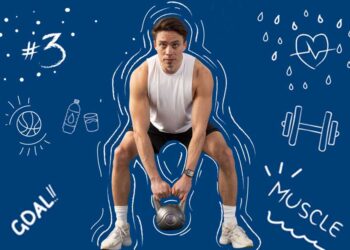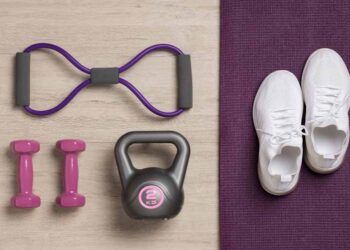Table of Contents
Embarking on a fitness journey can be both exciting and challenging. Whether you’re a beginner looking to get in shape or someone who’s had a fitness hiatus, starting your fitness journey on the right foot is crucial for long-term success.
But where do you begin? How do you avoid common mistakes that can hinder your progress and motivation? Is there a secret formula for building a sustainable workout plan and creating a healthy lifestyle?
In this article, we’ll guide you through the essential steps of starting your fitness journey. We’ll uncover common pitfalls to avoid, provide tips on setting realistic fitness goals, and highlight the importance of valuing the journey over the destination. Get ready to dive into a beginner’s fitness guide that will empower and inspire you to achieve your fitness goals!
Key Takeaways:
- Understand the emotional rollercoaster of starting a fitness journey.
- Define personal fitness goals that are specific and achievable.
- Value the journey over the destination for long-term success.
- Set realistic expectations and craft achievable goals.
- Create a flexible timeline that allows for adjustments.
01
of 08
Embracing the Fitness Mindset: The Key to Success
When starting a fitness journey, it’s important to develop a strong fitness mindset. This mindset can help you overcome challenges, stay motivated, and achieve your fitness goals. In this section, we will explore the different aspects of the fitness mindset that are crucial for success.
Understanding the Emotional Rollercoaster
Embarking on a fitness journey can bring about a whirlwind of emotions. From excitement and determination to anxiety and self-doubt, it’s normal to experience a wide range of feelings. It’s important to recognize and understand these emotions as they arise. By acknowledging and accepting them, you can effectively manage them and prevent them from hindering your progress.
Defining Personal Fitness Goals
Setting clear and achievable fitness goals is essential for staying on track and making progress. By taking the time to define your goals, you can establish a sense of purpose and direction in your fitness journey. Whether your goals are related to weight loss, strength building, or overall health improvement, they should be specific, measurable, and realistic. Breaking down these goals into smaller milestones can also help you stay motivated and focused.
Valuing the Journey Over the Destination
While reaching your desired fitness outcome is important, it’s equally important to appreciate the journey itself. Instead of solely focusing on the end result, learn to find joy in the process. Celebrate small victories along the way, such as completing a challenging workout or making healthier choices. By adopting this mindset shift and finding fulfillment in the daily efforts, you can cultivate sustainable habits and maintain long-term motivation.
To illustrate the importance of valuing the journey, let’s take a look at the concept of “fitness mindset” from a visual perspective:
“Fitness Mindset is like a marathon, where every step is an opportunity to grow and improve. It’s not just about crossing the finish line, but rather, enjoying the scenery, overcoming obstacles, and celebrating each milestone along the way.”
By embracing the fitness mindset and incorporating these strategies into your journey, you can set yourself up for long-term success. In the next section, we will explore the importance of setting realistic expectations and how it can be your strategic advantage.
02
of 08
Setting Realistic Expectations: Your Strategic Advantage
When starting a fitness journey, it is crucial to set realistic expectations. By doing so, you can maintain motivation and avoid discouragement along the way. Setting achievable goals and creating a flexible timeline for success are powerful strategies to help you stay on track and make gradual progress.
Crafting Achievable Goals
One of the keys to success in fitness is to craft achievable goals. Instead of aiming for grandiose outcomes that may be overwhelming, break down your goals into manageable steps. Start by identifying specific targets that align with your overall vision. For example, if your ultimate goal is to run a marathon, begin by setting smaller goals like running a 5K or completing a half marathon. These smaller milestones will keep you motivated and give you a sense of accomplishment along the way.
Creating a Flexible Timeline for Success
Creating a timeline for your fitness goals is essential, but it is equally important to allow for flexibility. Life can throw unexpected challenges our way, and having a rigid timeline can lead to frustration or burnout. Instead, build in flexibility by setting a general timeline that considers potential setbacks and adjustments. This allows you to adapt and make necessary changes without feeling overwhelmed. Remember, progress takes time, and it’s important to be patient with yourself.

Why Overambition Can Lead to Burnout
While it’s natural to be enthusiastic and passionate about your fitness journey, overambition can actually hinder your progress and lead to burnout. Pushing too hard too soon can increase the risk of overexertion and overtraining, which can result in injuries and fatigue. It’s important to strike a balance between pushing your boundaries and allowing your body and mind to rest and recover. By pacing yourself and preventing overtraining, you can maintain consistency and avoid setbacks on your fitness journey.
By setting realistic expectations, crafting achievable goals, creating a flexible timeline, and avoiding overambition, you can strategically position yourself for long-term success in your fitness journey. Embrace the process, celebrate small victories, and remember that gradual progress is sustainable progress.
03
of 08
Starting Slow: The Art of Progressive Overload
When beginning a fitness journey, it’s important to start slow and gradually increase the intensity of your workouts. This approach allows your body to adapt and grow stronger over time. One effective method for achieving this gradual progression is through the concept of progressive overload.
Progressive overload involves progressively challenging your body by increasing the demands placed on it. This can be done by gradually increasing the weight, repetitions, or duration of your exercises over time. By implementing progressive overload, you can ensure that your workouts continue to stimulate your muscles and promote growth.
For beginners, progressive overload can be achieved by starting with lighter weights and gradually increasing the resistance as you become stronger. It’s important to listen to your body and not push yourself too hard too soon. This gradual increase in intensity allows your muscles, tendons, and cardiovascular system to adapt and respond positively.
Additionally, incorporating a variety of exercises that target different muscle groups can help you achieve a well-rounded workout routine. By focusing on building strength and stamina through progressive overload, you will gradually improve your overall fitness level and set a solid foundation for your fitness journey.
| Benefits of Progressive Overload | How to Implement Progressive Overload |
|---|---|
| * Builds strength and muscle * Increases endurance and stamina * Improves overall fitness level * Prevents plateaus in progress * Enhances mental resilience and determination | 1. Start with lighter weights or lower intensity exercises 2. Gradually increase the weight, repetitions, or duration 3. Take adequate rest and recovery days 4. Listen to your body and make adjustments as needed 5. Seek guidance from a fitness professional if necessary |
04
of 08
Creating a Balanced Workout Routine
A well-rounded fitness routine is crucial for achieving optimal results and overall fitness. By combining strength training and cardiovascular exercises, beginners can effectively improve their overall health and fitness levels.
Combining Strength Training with Cardiovascular Exercises
Strength training and cardiovascular exercises offer unique benefits that complement each other. Strength training helps build muscle strength and endurance, improves bone density, and boosts metabolism. On the other hand, cardiovascular exercises, such as running, cycling, or swimming, improve cardiovascular health, increase stamina, and aid in weight management.
To create a balanced routine, beginners can incorporate both types of exercises into their workout plan. This can be done by alternating strength training sessions with cardiovascular workouts throughout the week. For example, strength training can be focused on specific muscle groups for one or two days, followed by cardiovascular exercises on the remaining days. This approach ensures that all major muscle groups are targeted while also improving cardiovascular fitness.

Incorporating Rest Days for Optimal Recovery
Rest days are essential for the body to recover and rebuild after intense workouts. It’s important for beginners to include rest days in their workout routine to prevent overtraining, injuries, and burnout. Rest days allow the muscles to repair and adapt after the stress of exercise, leading to improved performance and reduced risk of injury.
For optimal recovery, beginners should aim to have at least one or two rest days per week. On these days, engaging in low-impact activities like stretching, yoga, or light walking can help promote blood circulation and enhance recovery. Listening to the body’s cues and taking adequate rest is crucial in maintaining a healthy and balanced fitness routine.
Adapting Your Routine as You Progress
As beginners progress in their fitness journey, it’s important to continually challenge the body and avoid hitting a plateau. Adapting the workout routine can help keep the body stimulated and prevent stagnation.
Here are some strategies for modifying exercises and increasing intensity:
- Progressively increase weights or resistance in strength training exercises.
- Incorporate interval training by alternating between high-intensity and low-intensity cardiovascular exercises.
- Try new workout variations or exercises to target different muscle groups.
By gradually increasing the intensity and variety of the workout routine, beginners can continue to see progress and achieve new fitness milestones.
| Workout Recovery Tips | Adapting Workout Routine |
|---|---|
| 1. Prioritize sleep to allow the body to repair and recover. | 1. Gradually increase weights or resistance in strength training exercises. |
| 2. Stay hydrated to support muscle function and recovery. | 2. Incorporate interval training for cardiovascular exercises. |
| 3. Use foam rollers or massage tools to reduce muscle soreness. | 3. Try new exercise variations or techniques. |
of 08
How to Start Your Fitness Journey? Navigating Common Obstacles
Navigating common obstacles is an integral part of any fitness journey. As beginners embark on their path towards a healthier lifestyle, they often encounter challenges that can hinder their progress. In this section, we will address some of the most common obstacles faced by beginners and provide strategies for overcoming them, ensuring they stay motivated and achieve their fitness goals.
One of the most significant obstacles beginners face is a lack of motivation. Starting a fitness journey can be challenging, and at times, it may feel overwhelming. However, staying motivated is crucial to sustain progress. To overcome this obstacle, it’s important to find sources of inspiration and remind oneself of the reasons for starting the journey. Setting realistic goals and tracking progress can also help maintain motivation.
Dealing with setbacks is another obstacle that many beginners encounter. It’s essential to understand that setbacks are a natural part of the process and should not discourage someone from continuing their fitness journey. Instead of letting setbacks derail their progress, beginners should view them as learning experiences and opportunities for growth. Adapting and readjusting their approach can help them overcome setbacks and keep moving forward.
Finding support is vital for overcoming obstacles and staying on track. Joining fitness communities, partnering with a workout buddy, or seeking guidance from fitness professionals can provide the necessary encouragement and accountability. By having a support system in place, beginners can navigate challenges more effectively and receive guidance from experienced individuals who have overcome similar obstacles.
In conclusion, successfully navigating common obstacles is essential for beginners starting their fitness journey. By staying motivated, dealing with setbacks, and finding support, individuals can overcome hurdles and achieve their fitness goals. Remember that everyone’s journey is unique, and persistence is key. Embrace the challenges along the way, stay focused, and you will undoubtedly see progress towards a healthier and happier self.
06
of 08
Conclusion
Embarking on a fitness journey is an exciting and transformative experience. By avoiding common pitfalls and implementing key strategies, anyone can achieve their fitness goals and experience long-term success. Throughout this article, we have discussed the importance of understanding the emotional rollercoaster, defining personal fitness goals, valuing the journey, setting realistic expectations, progressive overload, creating a balanced workout routine, and navigating common obstacles.
Keys to starting a fitness journey involve setting clear and achievable goals, focusing on gradual progress, and celebrating small victories along the way. It is crucial to maintain a positive mindset and embrace the journey itself, rather than solely focusing on the destination. By valuing the process and making adjustments when needed, individuals can sustain their motivation and continue to strive for improvement.
Achieving long-term fitness success requires dedication, perseverance, and consistency. It is important to stay motivated, even when faced with setbacks or challenges. Additionally, having a support system can provide accountability and encouragement throughout the journey. Remember, your fitness goals are within reach. Take action, stay committed, and enjoy the transformative power of a well-rounded fitness lifestyle.
07
of 08
FAQ
How do I start my fitness journey?
To start your fitness journey, begin by setting specific and achievable fitness goals. Create a workout plan that includes a combination of strength training and cardiovascular exercises. Gradually increase the intensity of your workouts, and be sure to incorporate rest days for optimal recovery.
What should I do if I’m feeling overwhelmed or anxious about starting my fitness journey?
It’s normal to feel overwhelmed or anxious when embarking on a new fitness journey. Remember to take it one step at a time, and focus on the process rather than the end result. Break your goals down into manageable steps and celebrate small achievements along the way. Don’t forget to prioritize self-care and listen to your body.
How important is it to define personal fitness goals?
Defining personal fitness goals is crucial for progress and success. By setting specific and achievable goals, you can stay focused and motivated throughout your fitness journey. Your goals will act as a roadmap and help you measure your progress along the way.
Why is it important to value the journey over the destination?
While reaching your fitness goals is important, it’s equally essential to enjoy the process. By valuing the journey, you can build sustainable habits and maintain motivation in the long run. Celebrate small victories and maintain a mindset that focuses on long-term growth rather than immediate results.
How can I set realistic expectations for my fitness journey?
Setting realistic expectations is key to maintaining motivation and avoiding discouragement. Craft achievable goals that are broken down into manageable steps. Take a gradual approach to progress, allowing yourself time to adapt and grow stronger. Be flexible with your timeline to account for setbacks and adjustments.
Why should I start my fitness journey slowly?
Starting slow and gradually increasing the intensity of your workouts is important to prevent burnout and injuries. By implementing progressive overload, which involves progressively challenging your body over time, you can build a solid foundation for your fitness journey and avoid plateaus.
What should be included in a well-rounded fitness routine?
A well-rounded fitness routine should include both strength training and cardiovascular exercises. Strength training helps build muscle and increase strength, while cardio exercises improve cardiovascular health and boost endurance. Be sure to incorporate rest days for optimal recovery and to prevent overtraining.
How do I overcome common obstacles that may arise during my fitness journey?
Navigating common obstacles is a normal part of any fitness journey. Lack of motivation, setbacks, and finding support can all pose challenges. Stay motivated by setting reminders, finding an accountability partner, and focusing on the positive changes you’re making. Don’t be afraid to ask for help or seek professional guidance when needed.














